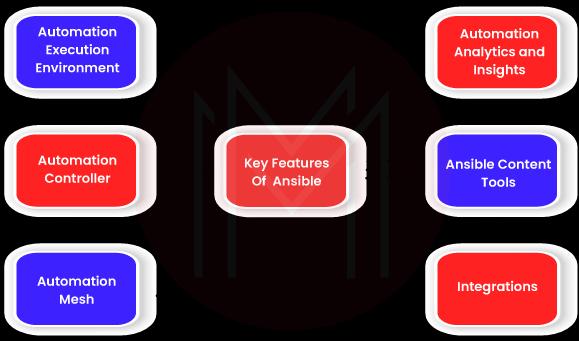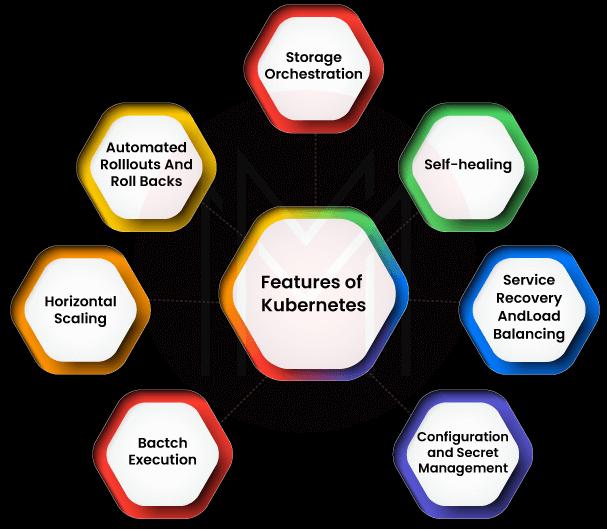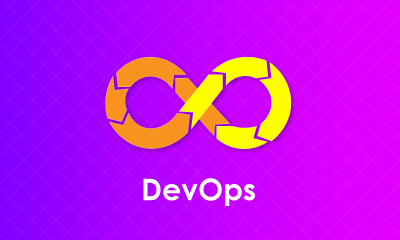Ansible and Kubernetes are two simple and powerful configuration automation tools. When it comes to Ansible, it effectively automates cloud provisioning, application deployment, and many more in an IT infrastructure. Considering Kubernetes, it follows the containerized approach to balance workloads, configures, deploys, and scales applications efficiently. No wonder you are now curious about knowing the similarities and differences between the tools.
This blog will detail the tools essential features, pros, and cons, similarities, and differences.
Let’s be ready!
Ansible vs Kubernetes - Table of Contents
- What is Ansible?
- Who Uses Ansible?
- Features of Ansible
- Advantages and Disadvantages of Ansible
- What is Kubernetes?
- Who Uses Kubernetes?
- Features of Kubernetes
- Advantages and Disadvantages of Kubernetes
- Similarities
- Differences
What is Ansible?
Ansible, the product of Red Hat, is an IT automation tool. It allows enterprise-level IT automation to configure all systems and devices in the infrastructure. In other words, Ansible automates the IT requirements such as cloud provisioning, application deployment, configuration, DevOps workflows, network automation, and many more. Know that Ansible uses a simple language YAML in the form of playbooks to perform configuration, deployment, etc.
Ansible allows effective collaborations among teams which in turn empowers IT operations significantly. Mainly, it implements multi-tire deployment managing many systems in the IT infrastructure simultaneously. On the same line, Ansible makes continuous deployments. It uses CI/CD methods to deploy applications in the target environment. Besides, you can scale automation across your enterprises without friction and reasonably control the processes.
| If you want to enrich your career and become a professional in Ansible, then enroll in "Ansible Training". This course will help you to achieve excellence in this domain. |
Before diving into the advantages and drawbacks of Ansible, let’s understand who uses Ansible and the key features of Ansible.
Who Uses Ansible?
Generally, operators, IT executives, administrators, release engineers, and IT managers can use Ansible to automate their IT infrastructure. Industries from small scale to large adopt Ansible for automating their IT processes. Especially, Ansible is used widely across IT and services, and communication sectors.
What are the Key Features of Ansible?
Ansible has many excellent features for performing IT automation. Let’s explore them as follows:

1. Automation Execution Environments
The automation execution environment is a container image that helps construct an execution environment. Therefore, you can automate complex IT processes in a standard way. Container images usually run Ansible playbooks as well as roles. And with this, automation environments simplify automation execution providing a portable, defined, and consistent environment. What’s more! The execution environment acts as the common language between automation engineers, platform administrators, and architects.
2. Automation Controller
It standardises how automation is deployed, initiated, and audited. Therefore, users can deploy automation confidently. Automation controller has many essential features such as User Interface (UI), Workflow, Role Based Access Control (RBAC), and CI/CD. They help to enhance the flexibility and efficiency of IT automation in a significant way. In the same way, the automation controller helps to manage inventories and workflows, track changes in IT processes, reports, and many more using centralized UI and REST APIs.
3. Automation Mesh
With a bi-directional communication layer, the automation mesh simplifies the scaling process. It helps to increase flexibility in deployments automatically, and at the sametime – without compromising control and visibility. Moreover, automation mesh has many security features such as digital signing, additional access controls, TLS traffic encryption, etc.
4. Automation Analytics and Insights
Analytics and insights measure the performance of the automation carried out by Ansible in-depth. In other words, analytics and insights provide the health status of automation with actionable data so that you can make informed decisions. Simply put, they help to track and manage automation closely. As a result, you can dramatically reduce risks and threats, and potential downtime in the IT infrastructure.
5. Ansible Content Tools
You can design, build, deploy, and manage execution environments with these tools. In this regard, the execution environment builder, also known as Ansible Builder, serves as a command line tool. This tool allows automation operators to build execution environments quickly. Similarly, an automation content navigator, also known as Ansible Navigator, provides a command line interface to Ansible environments. In fact, Ansible allows you to copy content from the UI and use them in other content.
6. Integrations
Ansible can integrate with any infrastructure – no matter who the vendor is. And Ansible's simplicity and agentless architecture allow DevOps teams to work with network teams. Ansible connects DevOps teams and tools to automate workflows in everyday operations. Always, Ansible can integrate and automate the cloud ecosystem as well as on-premises seamlessly.
What are the Advantages and Disadvantages of Ansible?
Advantages of Ansible
Let’s now know the advantages of Ansible below:
- Ansible is a tool that is simple to learn and use. Playbooks in Ansible are easy to write.
- Ansible is written in python language, which is easy to understand.
- Ansible has agentless architecture, which in turn eases maintenance and performance.
- It offers good security and reliability to the IT infrastructure. With Secure Shell Protocol (SSH), Ansible increases the security of applications.
- In addition to the existing operating system credentials, Ansible ensures access control by integrating Ansible with authentication management systems such as LDAP, Kerberos, etc.
Disadvantages of Ansible
No tool is perfect, undoubtedly. So, Ansible also has a few drawbacks. Now, we will check them out below.
- Users need to use CLI most of the time since GUI is underdeveloped in Ansible
- Ansible is a stateless system. So, it doesn’t track the changes in their dependencies
- It is challenging to deal with large volumes of data in Ansible
- Debugging capabilities are not satisfactory in Ansible
- Windows support is not a full-fledged feature in Ansible. That’s why a Linux control machine is mandatory in Ansible for managing Windows hosts.
- As Ansible is a new tool, the user community in Ansible is smaller.
What is Kubernetes?
Kubernetes, also known as K8s, is an open-source, portable, and extensible automation platform hosted by CNCF. Here, CNCF is referred to Cloud-Native Computing Foundation. Basically, Kubernetes is a container orchestration engine. That means Kubernetes automates deployment, scaling, etc., of containerized applications. Mainly, Kubernetes is good at orchestrating microservices-based applications that usually have many components for performing their operations. And it manages failover of containerized applications by replacing and rescheduling containers. Besides, Kubernetes provides the building blocks for building developer platforms.
Before diving into the advantages and drawbacks of Kubernetes, let’s understand who uses Kubernetes and the key features of Kubernetes.
Who Uses Kubernetes?
Kubernetes can be used in banking, software development, IT and services, communications, finance, etc.
Well! Before diving into the advantages and drawbacks of Kubernetes, let's see the overview of Kubernetes as follows:
What are the Key Features of Kubernetes?
Kubernetes is nothing short of Ansible in terms of its features. Let’s discuss the features of Kubernetes as below:

1. Automated Rollouts and Rollbacks
Know that the growing ecosystem of Kubernetes simplifies deployment solutions. Without killing instances in the infrastructure, Kubernetes rolls out changes in applications and configuration seamlessly. Of course! Kubernetes automatically creates new containers replacing existing ones if they don't function properly.
2. Storage Orchestration
Kubernetes automates storage systems – no matter whether they are in the cloud or on-premises. For instance, the storage system may be on-premises or public cloud providers such as GCP, AWS, etc. Or, it may be shared network storage such as iSCSI, NFS, etc.
3. Self-healing
Kubernetes automates restarting containers that fail to work. It replaces and reschedules containers on other nodes if the containers kill themselves. Not just that, Kubernetes kills containers that don’t respond permanently.
4. Service Recovery and Load Balancing
With the help of Pods, Kubernetes balances loads among applications. When traffic to a container is high, Kubernetes distributes the load to other containers and balances it efficiently.
5. Configuration and Secret Management
Kubernetes allows you to confidently store passwords, OAuth tokens, and SSH keys. Without rebuilding images, you can deploy and update secrets as well as application configuration in Kubernetes.
6. Batch Execution
Replacing the containers that don’t work, Kubernetes effectively manages batch and continuous integration (CI) workloads.
7. Horizontal Scaling
You can scale applications up and down with a single command. Or else, it has to be performed with the support of GUI.
[ Check out Kubernetes Architecture ]
What are the Advantages and Disadvantages of Kubernetes?
Similar to Ansible, Kubernetes also has many pros and cons on its side. Let’s take a look at them below:
Advantages of Kubernetes
- With Kubernetes, you can handle large workloads. Also, you can move them on-premises to clouds quickly.
- It supports different types of workloads – no matter whether it is stateful or stateless.
- Kubernetes’s container orchestration allows no downtime. So, Kubernetes ensures consistent delivery to users, whether the applications are complex or not.
- Kubernetes is great at scaling and capable of managing any traffic pattern. It’s not a surprise that you can scale applications without increasing the size of the operations team.
- Self-healing with an auto-repair mechanism is one of the critical advantages of Kubernetes.
- Kubernetes offers unsupervised rollbacks and rollovers, which in turn avoids downtime.
- It offers flexibility to choose your desired networking, storage, etc.
Disadvantages of Kubernetes
No wonder Kubernetes has a few drawbacks as well. Let’s have a look at them.
- Kubernetes has a steep learning curve. So, beginners will feel difficulty learning this tool.
- Migration to Kubernetes is a tedious process. Definitely, it would help if you had the support of technical people for this migration.
- Kubernetes uses CLI. But, working with CLI needs training and practice.
- In a way, flexibility creates complexity, which creates difficulty in designing.
What are the Similarities Between Ansible and Kubernetes?
Know that many similarities exist between Ansible and Kubernetes. The following chart will help you briefly know the similarities between the two.
| Ansible | Kubernetes | |
| Open source | Yes | Yes |
| Automation | Yes | Yes |
| Configuration management | Yes | Yes |
| Cloud platform | Private, Public, Hybrid | Private, Public, Hybrid |
| Flexibility | Good | Good |
| CI/CD deployment Support | Yes | Yes |
What are the Key Differences Between Ansible and Kubernetes?
Many differences exist between Ansible and Kubernetes, although they have many similarities between them. Let's compare the differences as follows:
- Platform: At a root level, Ansible is an IT automation tool, whereas Kubernetes is the container orchestration tool. Ansible mainly configures and provisions systems, manages IT operations, deploys applications, and performs CI/CD deployments. On the other side, Kubernetes performs managing workloads, rolling out updates, deployment, and scaling.
- Installation: installing Ansible is simple when compared to Kubernetes. This is because installation in Kubernetes demands careful planning before the process. Ansible doesn't support Windows operating systems, whereas Kubernetes supports all operating systems platforms.
- Ease of use: Working with Ansible is effortless and doesn't demand any specific knowledge. On the other hand, you need prior knowledge of Cloud-native systems, Docker, and Networks to work with Kubernetes.
- Ease of learning: As Kubernetes has many objects, it has a steep learning curve. On the contrary, the learning curve is flat in Ansible.
- Programming Languages: Ansible is written in Python programming, whereas Kubernetes is written in Go programming.
- Performance: Compared with Ansible, Kubernetes can effectively handle workload fluctuations by managing containers.
- Scaling: Scaling can be efficiently carried out in Kubernetes compared to Ansible.
- Community: The user community is significant in Kubernetes. Comparatively, it is small in Ansible since it is a newly released tool.
- Alternatives: Mirantis, AWS, G2 deals, Saltstack, and Portainer are a few alternatives for Kubernetes. Similarly, GitLab, Circle CI, Jenkins, and Progress Chef are a few alternatives for Kubernetes.
[ Also Check out Kubernetes vs Openshift ]
Conclusion
We hope this blog should have helped you understand Ansible and Kubernetes from all corners. To sum up, although Ansible is a new tool, it is increasingly being used by many companies simply because of its key functionalities. On the other side, Kubernetes has a large user community because of its load balancing, scaling, and deployment capabilities. In short, Ansible is a simple, flexible, powerful, easy-to-use, and efficient tool. On the other hand, Kubernetes is a self-monitoring, scalable, load balancing, and flexible tool. All right! Which one is the best tool – Ansible or Kubernetes? Now, the ball is in the hands of users. Yes! It ultimately depends on users' requirements to choose the tool that will satisfy their needs.
 On-Job Support Service
On-Job Support Service
Online Work Support for your on-job roles.

Our work-support plans provide precise options as per your project tasks. Whether you are a newbie or an experienced professional seeking assistance in completing project tasks, we are here with the following plans to meet your custom needs:
- Pay Per Hour
- Pay Per Week
- Monthly
| Name | Dates | |
|---|---|---|
| Ansible Training | Jan 03 to Jan 18 | View Details |
| Ansible Training | Jan 06 to Jan 21 | View Details |
| Ansible Training | Jan 10 to Jan 25 | View Details |
| Ansible Training | Jan 13 to Jan 28 | View Details |

Madhuri is a Senior Content Creator at MindMajix. She has written about a range of different topics on various technologies, which include, Splunk, Tensorflow, Selenium, and CEH. She spends most of her time researching on technology, and startups. Connect with her via LinkedIn and Twitter .
















